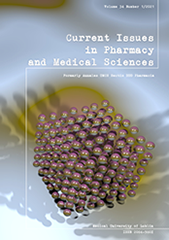The study of phenolic compounds and antioxidant activity of raw materials of Heliopsis helianthoides (l.) sweet
DOI:
https://doi.org/10.2478/cipms-2021-0006Keywords:
phenolic compounds, antioxidant activity, Heliopsis helianthoides (L.), Sweet, HPLCAbstract
Using high performance liquid chromatography (HPLC), we studied the chemical composition and antioxidant activity of bioactive substances in the roots, leaves, flowers and seeds of Heliopsis helianthoides. The results of our study showed the presence of 5 phenolic compounds in its roots, 4 phenolic compounds in its leaves, 10 phenolic compounds in its flowers and 8 phenolic compounds in its seeds. The highest content of identified compounds was found in the leaves of this plant – 3192.20±79.78 mg/kg. The dominating hydroxycinnamic acid was chlorogenic acid. This had its highest concen-tration (1537.21±38.43 mg/kg) in the Heliopsis helianthoides leaves. Among flavonoids, luteolin prevailed in the roots, apigenin-7-glucoside prevailed in the seeds and rutin prevailed in the leaves and flowers. Maximum rutin content (1426.64±35.67 mg/kg) was found in the Heliopsis helianthoides leaves.
Antioxidant activity study in vitro uncovered the substantial antioxidant potential of bioactive substances (BASs) in all tested samples of the raw materials, being within the limits of 2.81-8.13 mg/g. Most active in this respect were Heliopsis helianthoides leaves. The obtained data indicate the feasibility of the development of new antioxidant active drugs on the basis of raw materials of Heliopsis helianthoides.
References
1. Karamać M, Kosińska A, Estrella I, Hernández T, Dueñas M. Antioxidant activity of phenolic compounds identified in sunflower seeds. Eur Food Res Tech. 2012;235:221-30.
2. Temple N. Antioxidants and disease: more questions than answers. Nutr Res. 2000;20:449-59.
3. Pavlenko-Badnaoui M, Protska V, Zhuravel I. The study of the mineral composition of Heliopsis helianthoides. Norwegian J Develop Int Sci. 2019;31:50-3.
4. Aguilar MI, Castillo N, Aguilar-Guadarrama AB, Rios MY. Quality specifications of identity and composition for the medicinal plant Heliopsis longipes. Planta Med. 2008;74:PC98.
5. Hajdu Z, Haskó J, Krizbai IA, Wilhelm I, Jedlinszki N, Fazakas C, et al. Evaluation of Lignans from Heliopsis helianthoides var. scabra for Their Potential Antimetastatic Effects in the Brain. J Nat Prod. 2014;77(12):2641-50.
6. Hajdu Z, Nicolussi S, Rau M, Lorántfy L, Forgo P, Hohmann J, et al. Identification of Endocannabinoid System-Modulating N-Alkylamides from Heliopsis helianthoides var. scabra and Lepidium meyenii. J Nat Prod. 2014;77(7):1663-9.
7. Olivas-Quintero S, López-Angulo G, Montes-Avila J, Páz Díaz-Camacho S, Vega-Aviña R, López-Valenzuela JÁ, et al. Chemical composition and biological activities of Helicteres vegae and Heliopsis sinaloensis. Pharm Biol. 2017;55(1):1473-82.
8. Islam RT, Islam AT, Mazumder K. In vitro antioxidant activity of methanolic extract of Helianthus annuus seeds. J Med Plants Stud. 2016;4(2):15-7.
9. Glushchenko A, Bezruk I, Ivanauskas L, Georgiyants V. Development of the method of simultaneous quantitative determination of loratadine and auxuilary substances in the combined syrup «Loratadin+». ScienceRise: Pharmaceutical Sci. 2019;2(18):39-47.
10. Raudonis R, Jakštas V, Burdulis D, Benetis R, Janulis V. Investigation of contribution of individual constituents to antioxidant activity in herbal drugs using postcolumn HPLC method. Medicina (Kaunas). 2009;45(5):382-94.
11. Raudonis R, Raudone L, Jakstas V, Janulis V. Comparative evaluation of post-column free radical scavenging and ferric reducing antioxidant power assays for screening of antioxidants in strawberries. J Chromatogr A. 2012;1233:8-15.
12. Wu L. Effect of chlorogenic acid on antioxidant activity of Flos Lonicerae extracts. J Zhejiang Univ Sci B. 2007;8(9):673-9.
13. Liang N, Kitts DD. Role of Chlorogenic Acids in Controlling Oxidative and Inflammatory Stress Conditions. Nutrients. 2016;8(1):16.
14. Enogieru AB, Haylett W, Hiss DC, Bardien S, Ekpo OE. Rutin as a Potent Antioxidant: Implications for Neurodegenerative Disorders. Oxid Med Cell Longev. 2018.
15. Yang J, Yuan J, Guo J. In vitro antioxidant properties of rutin. LWT Food Sci Technol. 2008;41(6):1060-6.
16. Zielińska D, Szawara-Nowak D, Zieliński H. Determination of the antioxidant activity of rutin and its contribution to the antioxidant capacity of diversifed buckwheat origin material by updated analytical strategies. Pol J Food Nut Sci. 2010;60 (4):315-21.
Downloads
Published
Issue
Section
License
Copyright (c) 2021 Authors

This work is licensed under a Creative Commons Attribution-NonCommercial-NoDerivatives 3.0 Unported License.


